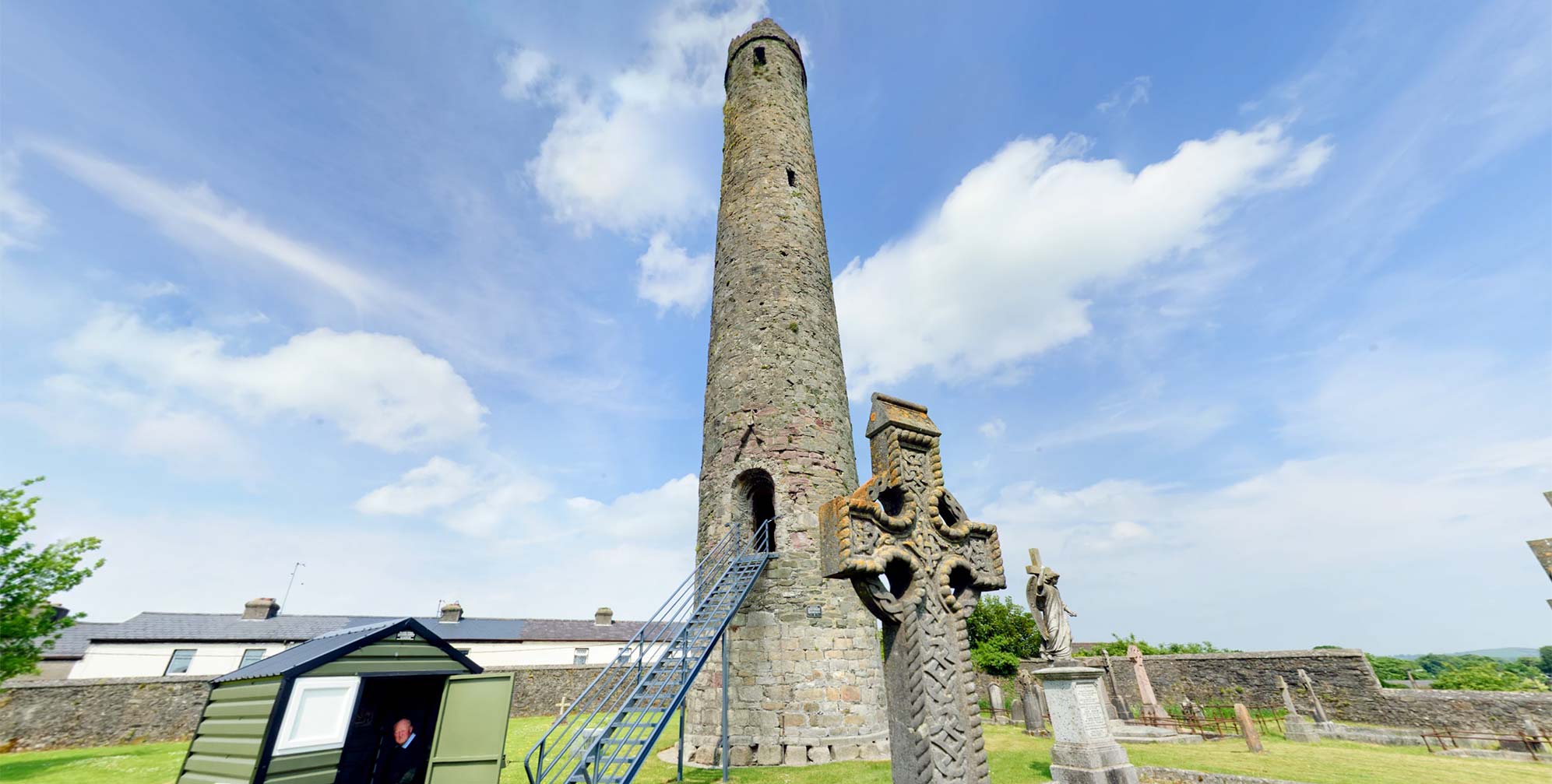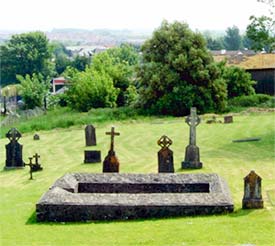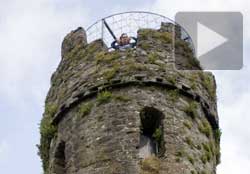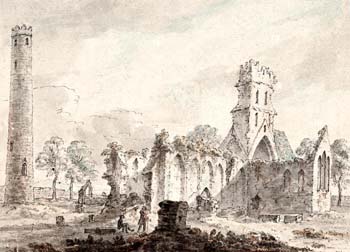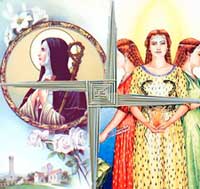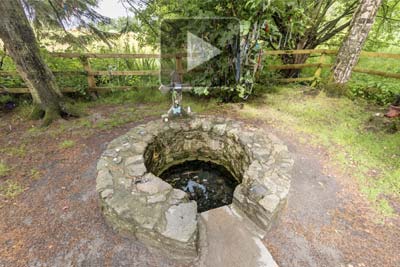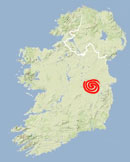08 Sep Kildare Round Tower
and St. Brigid’s Fire Temple
“…the round towers were constructed by early Indian colonists of Ireland (the Tuath-de-danaans), in honour of ‘the fructifying principle of nature,’ of which the sun and moon are representative. The emblem of this principle was the phallus in the case of the sun, and the crescent in that of the moon. The round tower was simply a monumental phallus…”
Henry O’Brien, 1833 1
“[Brigid’s Fire Temple] is surrounded by a hedge, made of stakes and brushwood, and forming a circle, within which no male can enter; and if any one should presume to enter, which has been sometimes attempted by rash men, he will not escape the divine vengeance.”
Giraldus Cambrensis, 1187 2
On a fabled hilltop in Kildare town, in a churchyard that has seen its great cathedral rise from ruin many times in its 1500 year history, sit two stone structures, the yin and yang of Irish architectural symbolism, or possibly the yoni and lingam. The restored foundation of St. Brigid’s Fire Temple recalls the most significant woman of Early Christian Ireland, or perhaps her pagan namesake. It still serves today as a pilgrimage destination for spiritual women from the ranks of Christians and neo-pagan alike. The adjacent—and better known—Kildare Round Tower was in the 19th century believed by some to also be an example of a pagan temple: its tall, ramrod-straight form, with its original conical cap, revealing its ancient use in homage of what one 1834 reviewer termed “a certain particular division of the [male] anatomy, which the refinement of modern civilization has excluded from decent language.3
In the virtual-reality environment above you can click on the hotspot on the stairway to enter the round tower. Once in the doorway, look up to note the Romanesque carvings. Then enter the tower and click on the hotspot on the ladder to ascend to the observation platform at its summit. There you can then look out onto the panoramic bird’s eye view of Kildare. The other hotspot in the graveyard will lead you to the reconstructed foundation of St. Brigid’s Fire Temple; additional hotspots there will take you inside the structure and allow a close-up view of some items left by her pilgrims.
Kildare’s Cathedral Church of St. Brigid today is largely the result of a 19th-century restoration of the Norman structure of 1230. In legend, the hill on which it sits was in prehistory the site of a pagan temple to the Celtic goddess Brigid (see below). There was a Christian church here from the end of the fifth century, a simple thatched-roof structure, built under an oak tree, and named by St. Brigid Cill Dara, the Church of the Oak, from which derives the modern name of the county and city of Kildare. This church evolved to an early medieval stone structure with a defensive as well as a religious function. It was attacked and devastated some 16 times between the years 835 and 998. It was a ruin when Ralph of Bristol became the bishop in 1223. He finished its reconstruction in its present gothic style by 1230, but the building was again partially in ruin by 1500 and abandoned by 1649 (see the Dawson and Seymour prints below).
Completely restored in 1896, it currently serves a small local parish of the Church of Ireland and houses a small museum, closed to tourists during the winter months.4
The Round Tower
Think of Ireland, and you’re likely to conjure first a shamrock, then perhaps a harp. Or a Guinness. But close behind the list of symbols that are forever Irish would be the iconic but enigmatic round tower, with its doorway positioned high off the ground. These old structures, though always located within ecclesiastical sites, have nevertheless been the topic of generations of speculation divorcing them from any Christian connection. Even today, newly minted theories about the purpose of the round towers are still coming out of the stonework. It should not be surprising that such imposing structures, with no contemporary records of their construction,5 should be seen as a mirror on which some in each generation can see reflected their own mythic ideals. To many of the 19th-century antiquarians, “a Round Tower of two or even three thousand years’ standing was twice as satisfying as one of a mere eight hundred years…” 6
Archaeologists today largely agree that the Irish round towers were constructed as monumental belfries and perhaps places of temporary refuge or for storage of valuables. The Irish term always used to describe them is cloig-theach, or bell-house. They may date from as early as the sixth century, with their construction continuing through the 13th century.7 The contemporary reviews of Henry O’Brien’s book (see quotation at the top of this page), which proclaimed the towers to be built a thousand years before Christ, constructed primarily as sites for phallus worship, were very harsh. O’Brien gained his notoriety largely because his bizarre theories could not be mentioned in polite society. As Joep Leerssen put it:
“O’Brien’s name was made famous by becoming the subject of scandal and ridicule; his theory was given exemplary status by being so memorably unmentionable in polite society…” 8
Most reviews of O’Brien’s work were so scathing that they likely contributed to his insanity and death at the age of 27 in 1835.
Quite aside from the speculation of this tragic 19th-century antiquarian, some of the Irish round towers have been the focus of more traditional indigenous folklore. In a common tale, the tower at Cloyne (Co. Cork) was “built in one night by St. Colman to safeguard his relics.” 9
At Aghagower (Co. Mayo) the legend has it that after the tower’s cap and bell were blown a half mile away by a bolt of lightning, the old people could still hear the bell “giving tongue” from beneath the bog where it landed.10 Another tower where the bell was magically thrown into a nearby lake was at Kilmacduagh in Co. Galway (see photo in gallery).
One legend is that all Ireland’s round towers were constructed by a single builder known as the Gobán Saor. These tales may have evolved from the mythological exploits of Goibniu, the smith of the Tuatha Dé Danann. Whatever the source of these tales, the similar construction of all the round towers points to the likelihood of roving teams of builders, moving with their architect from site to site.11
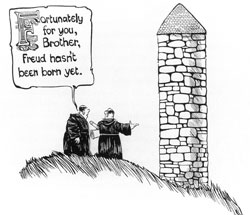
Martyn Turner, Illuminations: 101 Drawings of Early Irish History. Used with permission.
In the tourism literature the Irish round towers are reputed to have served primarily as a type of fort where monks might retreat with all their treasures when an attack from the plundering Vikings was imminent. Although some towers may have served as temporary places of refuge, it is unlikely that they were built solely for such a purpose. The wooden doors and floors of these tall chimney-like structures would have presented inviting targets for the flaming arrows of the Vikings. Indeed, some towers show evidence of fire damage around the entrances, and there are accounts of people being burned to death in the towers.12 Furthermore, some of the round towers were constructed within the areas of Viking townships, an unlikely place to construct a refuge from the Danes.13
Prior to the arrival of the Normans in 1167, the round towers may have been the only noteworthy buildings constructed of stone in Ireland, at a time that the first church structures were made of wood.14 They may have been constructed with round sides simply because using stone rubble to construct a rounded building was relatively easy; it was more costly to transport and dress the stone blocks needed for a building with corners.15 The doorways in these towers, which could be six meters, or almost 20 feet from the ground, were positioned above a lower story entirely filled with rock rubble for stability.
There may have originally been some 120 round towers in Ireland. Most of the 65 now remaining are in a ruined state, with less than 20 in good condition. Only one retains its original conical cap, at Clondalkin, near Dublin. Kildare can boast five round towers, the most of any county in Ireland.16
The 32-m (105-ft) example in Kildare town is the second tallest in Ireland. Vertigo-resistant visitors—for a small fee—may enter and climb up the six flights of ladders to the battlements on top, added in the 1730s. It is one of only two round towers in Ireland currently (2013) allowing such access; the other is St. Canice’s in Kilkenny. The current floors and the ladders between them were added in 1874. The tower was most likely rebuilt in the 12th century onto the granite block foundation of the original structure dating from the sixth or seventh century.17
Henry O’Brien was by no means the only one to find exotic origins and purposes for Ireland’s round towers. British military surveyor Charles Vallancey, working in Ireland between 1770 and the turn of the century, became known as the foremost authority of his time on Irish antiquities. He claimed that the round towers were of Phoenician or Indo-Scythic origin and were the repositories of the sacred fires used to rekindle all the flames of Ireland once a year.18
In 1867 Marcu Keane proposed that the ancient builders in Ireland were not the Irish at all but “a highly civilized race of building celebrity…the Cuthities of Antiquity…” He wished to prove that the round towers were built “for the purpose of heathen worship, several hundred years before the Birth of Christ.”19 Many of the theories of the time were based on the racist assumption that the native Irish themselves would not have had the ability to produce great monuments of such antiquity.20
Theosophist and psychic (and associate of W. B. Yeats) Madame (Helena) Blavatsky claimed that the round towers and similar monuments were completed by “initiated priest-architects” long before the time of the Druids.21
In her 1873 book, Ireland: Ur of-the Chaldees, Anna Wilkes asserts that not only were the round towers pre-Christian, but that similar towers in the Far East were copied from the Irish originals, as “the first human families must have migrated from the West of Europe to Asia.” 22
But there was one man, writing at the same time that Henry O’Brien spun his tales, who did more than anyone else to retrieve for dispassionate scientific examination the study of Ireland’s round towers. In 1833 George Petrie won the gold medal from the Royal Irish Academy for his essay that firmly but politely, refuted the wilder theories that were dominating the discussion of the round towers.23 Petrie calmly laid out his evidence that the towers could not be anything other than Christian-era structures connected with ecclesial foundations, having nothing in common with architectural features of pagan constructions in Ireland.24
“I shall not, however, trespass on the reader’s time or patience by any formal refutation of theories, supported by such evidences or arguments as have been now laid before him: to do gravely would, I feel, equally involve me in ridicule with their author; and to treat them with levity would be foreign to my tastes and the spirit of this investigation. Besides if there be any that could be convinced by such reasonings, they would not be likely to have their faith shaken by any commentary that I could make upon them.” 25
As scholar and Ordnance Survey diarist John O’Donovan pointed out a few years later, if the prehistoric builders of the dry-stone fort of Dun Aengus had the same knowledge of mortar as the builders of the round towers they would certainly have used it. The fact that they did not must prove that the round towers are of a later date.26 The discovery of methods for radiocarbon dating of the components of mortar have added even more certainty to O’Donovan’s words.27
The same year that George Petrie won his gold medal, the very essay he most wished to refute, that of Henry O’Brien, won from the same Academy a consolation “bronze medal” award that one modern author asserts was given to him “to keep him quiet.” 28
The modern era of radiocarbon dating and scientific analysis has in no way put an end to the ability of the Irish round towers to act as muse for those on a personal quest for a deeper meaning within ancient architecture. In 2001 American agricultural scientist Phillip Callahan claimed to have discovered that the round towers were made of “paramagnetic stone” that resonates positively in a magnetic field.
“Could it not be that the good Irish monks were collecting a little of that cosmic paramagnetic energy and focusing it with round tower antennae onto the earth spots where they planted their crops?” 29
Callahan concluded that the round towers acted as a boon to agriculture, collecting weak magnetic radiation from the sun and transmitted it to the priests and then to the plants growing around the tower.
If John O’Donovan were alive today and asked to comment on these modern theories regarding Ireland’s antiquities, he might respond just as he did to the earlier theories in 1837:
“I never would dwell so much upon the reveries of those [theorists] if I did not see the ablest of our writers led astray by their fabrications and that most men incline more to believe what is romantic and imposing than dry truth. If Vallancey and [others] had published their works in the shape of Novels that would have done no harm, but as they have given their dreams the shape of grave history I think myself bound now, while the language of Ireland is living and while I have all the means of understanding it, to put posterity on their guard against them.” 30
Perhaps the best “theory” regarding the origin and purpose of the round towers was recorded by early folklorist T. Crofton Croker in 1824. He asked a peasant what he thought about a nearby round tower and was told that its purpose was “to bother posterity.”31
Some may feel that rejecting the Tuatha Dé Danann as the builders of the round towers or casting doubt upon their efficacy as radio transmitters may serve to diminish their impact. However, it must be remembered that when constructed they had a monumental effect, demonstrating to the local Christian community and to all visitors the great prestige of the church and its architectural—and symbolic—heights beyond the reach of the secular world.32
Brigid and her Fire Temple
“The mythic goddess Brigid and the historic St. Brigid blend together in this area and imbue it with their powerful united presence…her story encapsulates the melding of Irish paganism and Christianity, neither of which can contain her.” 33
Among her diverse devotees it is sometimes a topic of contention whether or not the St. Brigid of sixth-century Kildare inherited her sacred mantle from an eponymous pagan priestess of the Celtic Iron Age. Tying the two together, some believe the Christian saint was originally a convert from the community of acolytes tending the pagan sacred flame, “Brigid’s Fire,” on the site of what ultimately was to become the Fire Temple of St. Brigid. Their shared association with fire is one factor holding together the goddess Brigid with St. Brigid, Ireland’s female patron saint. The familiar rush-woven St. Brigid’s Cross may have derived its shape from a symbol of that most fiery of objects, the sun.34 A 1784 drawing of the ruin traditionally known as Brigid’s Fire Temple, or Fire House, may be seen in the gallery at the bottom of this page. Some scholars, however, believe the original Fire Temple was located outside the cathedral compound’s present-day walls.35 Within the virtual-reality environment, top left, there are three different views of the 1988 reconstruction of the Fire Temple foundation.

The Abbey and Round Tower at Kildare. Note the ruins of the Fire Temple to the left. (Rev. Mr. Seymour, 1783, Beranger Collection, UCD)
While there are of course no contemporary texts to describe the pagan goddess, this Brigid (Brighid, Brigit, or Bhríde, “Exalted One”) is thought by her devotees to have been a “triple goddess” of poetry, healing and smithcrafting. According to one account she was “born at the exact moment of daybreak, [and] rose into the sky with the sun, rays of fire beaming from her head.”36 Her protection was sought over livestock and agriculture. She was reputed to be the daughter of the great Celtic god Dagda and the Morrigan. As a fertility goddess, her aspects were venerated not only in Ireland but also in Britain and on the continent. The Celtic festival of Imbolc—marking the beginning of spring—midway between the winter solstice and the spring equinox, coincides with the first of February, the feast day of St. Brigid.37 According to her lore, she and her 19 virgin priestesses, called “Daughters of the Flame,” kept the blaze constantly burning in her original fire temple.
“She is provider of plenty, giver of life and is also identified with nurturing, fertility and fire. All wells are sacred to Brighid for they are the doorway to the Underworld and the womb of our Mother, the source of all life.” 38
There are many different threads of belief that have developed around this amorphous spirit, who, according to some sources, may have been the magical name used for evoking any number of pagan deities. While the list continues to evolve with the times, some aspects of her veneration include: Celtic Christian, Goddess Movement, Wiccan, and Neodrudic.39
Other voices, among them some historians and theologians, are skeptical of a direct link between a pagan goddess named Brigid and St. Brigid, the Abbess of Kildare’s earliest Christian era. According to these sources, the goddess Brigid was first introduced into the literature in the ninth-century Sanas Cormaic (Cormac’s Glossary). But it wasn’t until Whitley Stokes published his 1862 translation that the connection with the festival of Imbolc, and thus St. Brigid, was introduced. As one writer noted on her website:
“The idea that saint and goddess are the same entity can be traced back, not to far bygone ages, but to Victorian scholars heavily influenced by the historical and cultural factors that shaped their own age.” 40
It seems quite possible that the Fire Temple and its complement of 19 guardians seen at St. Brigid’s monastery in the 12th century by Giraldus may have been a continuation of a much earlier pagan tradition, but this may have been only a superficial similarity, connoting no resonance in its inward meaning, nor (as Lisa Lawrence phrased it) any sharing of the “same symbolic referent.”
“I would suggest that although Saint Brigit and her cult inherited some of the goddess’s attributes, the goddess herself was buried along with her last devotee…Saint Brigit is not a pagan goddess dressed up in Christian vestments; she is a Christian saint who has a few pagan adornments—the spoils of Ireland’s conversion”41

The St. Brigid’s Flame Monument was unveiled on St. Brigid’s Day (February 1), 2006 at Kildare’s Market Square.
While there are several Irish saints with the same name, St. Brigid of Kildare was born c. 450. Her first hagiography, written around 650, features legends that seem to evoke the essence of a pagan goddess, replete with magical stories involving cattle and agriculture, and also with sacred fire and holy wells—she is venerated at two wells within walking distance of her cathedral.42
According to some biographers, her pagan father was a local chieftain, and her mother, a Christian, a slave in his household. Healing and feeding the poor were among the miracles and wonders associated with the young nun. She was known as a peacemaker who brought healing reconciliation between rival clans. As a bishop, she established side-by-side monasteries, one for men and one for women. These were, in succeeding centuries, to develop into great centers of learning and the arts, with influence over a wide territory.
Not being able herself to administer the sacraments, Brigid appointed St. Conleth as pastor for both her foundations. How she came to be consecrated as a bishop, an honor never before (or since) bestowed upon a woman, was also miraculous. She was scheduled to take the veil as a nun, but the church leader performing the ceremony mistakenly read the prescribed prayers for ordaining a bishop. When challenged on this, he replied, “No power have I in this matter. That dignity has been given by God only to Brigid, beyond every other woman.”43
After her death in 525 it was said that her remains were set in a shrine of honor at the high altar of her cathedral, with a tomb “adorned with various ornaments of gold and silver.” No evidence of this exists today, nor of the reputed “Book of Kildare” whose glorious illuminations would have rivaled those of the Book of Kells.44 Her shrine, according to the Annals, was plundered by the Vikings c. 835, but not before her remains were safely removed to Downpatrick. There, according to tradition, they were discovered in 1185, and reinterred in Down Cathedral in a single tomb with the two other patron saints of the land, Patrick and Columba (Colm Cille).45 Lady Gregory wrote of St. Brigid in her Book of Saints and Wonders (1907):
“Lasting goodness that was not hidden; minding sheep and rising early; hospitality towards good men. It is she keeps everyone that is in straits and in dangers; it is she puts down sicknesses; it is she quiets the voice of the waves and the anger of the great sea. She is the queen of the south; she is the mother of the flocks; she is the Mary of the Gael.” 46
The virtual-reality tour (top) will taken you into Brigid’s Fire Temple, and once inside, a hotspot will allow a close-up view of the collection of artifacts left there by Brigid’s diverse followers. These items includes candles, costume jewelry, an acorn, a small sculpted head of Jesus, a cross medallion inscribed “Pray and Work,” ribbons, rags, flowers both real and plastic, and a stick of incense still burning when photographed at dusk on July 22, 2013. The person who lit the incense was gone by the time we arrived, so we could only guess from which stream of Brigidine devotion she came. She may have come to Kildare from anywhere in the world, as the Internet has provided a virtual dimension to the ancient traditions of the Daughters of the Flame. There is a web-based organization with that title, inviting women around the world to sign up for a their own local shift of flame-tending, on a 19-day rotation, with each woman tending her fire “in her own way.” The spirit of Brigid tends the flame on the 20th day.47
“I began my journey about 10 minutes before sundown. This was to be my first flame tending, and I was very excited. Something about it seemed so ancient, so powerful, and so familiar. I am very new to Brighid [yet] somehow I feel she’s been with me for much longer. I walked outside with my lantern to the circle of stones built to honor my ancestors; I placed the lantern in the center. I sat for a minute, with my mother, as we watched the sun go down. I said my oath, the genealogy of Brighid, and lit the flame. I felt honored, and blessed to be keeping her ancient flame.” 48
The original flame of St. Brigid of Kildare was extinguished in the 16th century by order of the Norman church hierarchy in its effort to end the trappings of the Celtic Church deemed overtly pagan.49 In 1993, at a conference entitled “Brigid: Prophetess, Earthwoman, Peacemaker,” the flame was ceremoniously re-lit in Kildare’s Market Square and ultimately given a place of honor there atop a bronze, oak-themed sculpture on St. Brigid’s Day (February 1) of 2006 (see photo, above left).
Just a few blocks east of the yin of the Fire Temple and the yang of the Round Tower there is today a small group of Roman Catholic nuns, the Solas Brídhe (Brigid’s Light) community of Brigidine Sisters, who proclaim themselves “a restoration of the ancient fifth-century Order of St. Brigid of Kildare.” The group’s mission includes enhancing spiritual opportunities for people of “all faiths and none,” and has set its focus to include not only the teachings of St. Brigid but also the paths of those who blend an understanding of the saint with their own “Celtic Spirituality.”50 Thus the order, perhaps unique among Catholic women religious, embraces the goddess tradition of their saint’s possible progenitor. While the sculpted monument with its flame stands in Kildare’s public square, the Solas Brídhe sisters lovingly tend the flame of St. Brigid’s Fire Temple at a sacred spot inside their home.
“Brigid is the woman who, above all others, embodies the spirit of pre-Christian Celtic and Christian Celtic Ireland. Her life inspires unity and reconciliation…’In her femininity, Brigid inclusively embraces many kinds of cross currents, some of them apparently contradictory—the ancient and the new, the pagan and the Christian, the animal and the human, the rich and the poor—and from this it is clear that her ample cloak can accommodate all kinds of apparently irreconcilable differences.'” 51
Click here to see all the notes from this page.
Kildare Round Tower and St. Brigid’s Fire Temple
Nearest Town: Kildare
Latitude: 53° 9′ 29.42″ N
Longitude: 6° 54′ 40.07″ W



